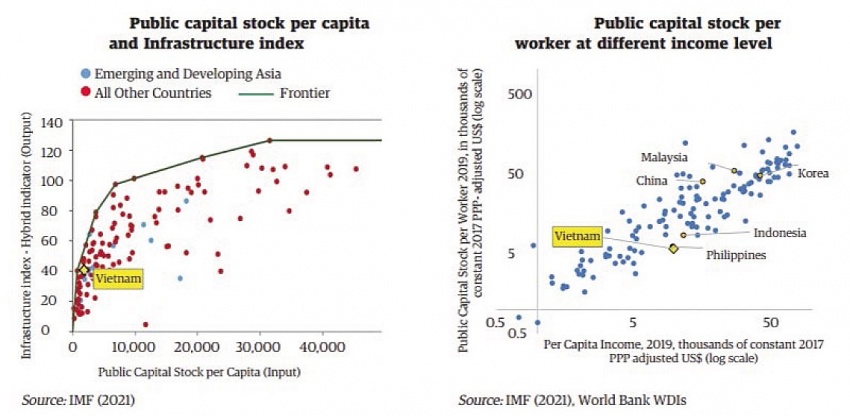Effective investment the way forward for infrastructure
Investing in these infrastructures will help the economy grow in two ways. It provides better infrastructure for the Vietnamese population to use in their daily work and life, which helps them be more productive. More public investments in critical infrastructure also allure more domestic and foreign investment, which makes the economy grow.
 |
| Dorsati Madani Senior economist World Bank in Vietnam |
Also, global climate changes make it essential to invest in adapting our public investment to the coming changes: more and harder rain, flooding, more heat, and the likes. Our roads, ports, schools, waterways, and other public infrastructures need to be more resistant to these weather changes. It takes money to upgrade our existing infrastructure and build better ones for the future, and public investment is the main source for this upgrade.
But even though there has been a need to spend more on public investment, in the past few years there has been less money spent and what was spent was not done very effectively.
In the past five years, only around three-quarters of the planned investment budget was executed. And between 2011 and 2019, in Vietnam, every six US dollars spent in public investment led to one dollar increase in output national income, much less than China, South Korea, or Thailand.
The government has tried to plan and coordinate these infrastructure projects, but there have been delays in planning and implementing the projects and a lot of duplication of projects between central government and local governments, which cause extra costs and is inefficient.
They can also lead to creating duplicate investments that are not always fully used, like many industrial parks or provincial ports that are not used fully. Vietnam has 47 seaports of all sizes across provinces, but 95 per cent of cargo goes through three ports invested and operated by the Ministry of Transport. So how many ports does Vietnam really need?
To resolve these issues, the latest Taking Stock report by the World Bank suggests that Vietnam should spend more on public investment and should improve the planning and management of public ventures. They can do this by making sure the projects are thoroughly considered from the beginning and by using better methods to estimate costs.
They should also consider how these projects can deal with climate change. The government should work on how they share money and decisions between the central government and local governments. This can help avoid duplication of projects and make sure money is spent on the right projects.
Overall, Vietnam needs to invest in the appropriate projects, manage these investments better, and think about how to deal with climate change. This will help them become a stronger and more developed country.
| In seeking to reach upper middle-income status by 2030 and high-income status by 2045, Vietnam aspires to become a modern and industrialised nation with a higher quality of life for its citizens. To achieve this, the government estimates that annual GDP growth must be maintained at 7 per cent during 2021-2030 and 6.5-7.5 per cent through 2031-2050. The country also needs to ensure that gross capital investments from all sectors account for 32-35 per cent of GDP on average from 2021 until 2030, including government investment at an average of 7.3 per cent of GDP annually to support infrastructure development during this period. Despite critical growing needs, Vietnam’s public investment level has declined in the past decade. Since 2011, the share of public investment in total government expenditures and GDP fell from 27 to 20 per cent, and 8 to 6 per cent, respectively. Yet the economy remains relatively capital scarce, with a public capital stock per capita and per worker well below upper middle-income countries and high-income countries. Meanwhile, global experience suggests that capital accumulation was the most important driver for fast-growing countries when they were at Vietnam’s level of development. Vietnam has ample fiscal space – with public and publicly guaranteed debt at 35.7 per cent of GDP in 2022 compared to the 60 per cent debt threshold set out by the National Assembly – and can spend more on public investment to boost sustainable growth. In the past 20 years, transport spending – roughly 23 per cent of general government capital spending and 3.5 per cent of GDP – has focused more on rural transport infrastructure (75 per cent), which is managed by provinces. Given budget constraints, this focus came at the expense of implementing nationally strategic investments. As a result, the expressway density in Vietnam is among the lowest in the East Asia-Pacific region, and the road transport costs are highest when compared to others in the region. Many segments along the North-South Expressway axis have not been constructed. Railway infrastructure has also been neglected. Source: Taking Stock – World Bank |
 |
What the stars mean:
★ Poor ★ ★ Promising ★★★ Good ★★★★ Very good ★★★★★ Exceptional
Related Contents
Latest News
More News
- Stress laid on high-quality FDI inflows (December 15, 2025 | 11:00)
- Can Tho utilises its growth advantages (December 15, 2025 | 09:09)
- Ca Mau unlocking potential to shape a more sustainable future (December 15, 2025 | 09:02)
- Major projects to be inaugurated nationwide (December 15, 2025 | 08:00)
- MoF workshop highlights mounting concerns over ODA on-lending costs (December 12, 2025 | 16:05)
- National Assembly approves pilot mechanisms to accelerate major projects in Hanoi (December 12, 2025 | 11:29)
- Legislation gives government flexibility for loan guarantees (December 11, 2025 | 18:04)
- Vietnam eases policy approval requirements, simplifies foreign and outbound investments (December 11, 2025 | 17:53)
- Vietnam masters core technologies of automobile value chain (December 11, 2025 | 17:46)
- VAL opens second line of largest soybean crushing complex in Southeast Asia (December 11, 2025 | 12:08)

 Tag:
Tag:






















 Mobile Version
Mobile Version